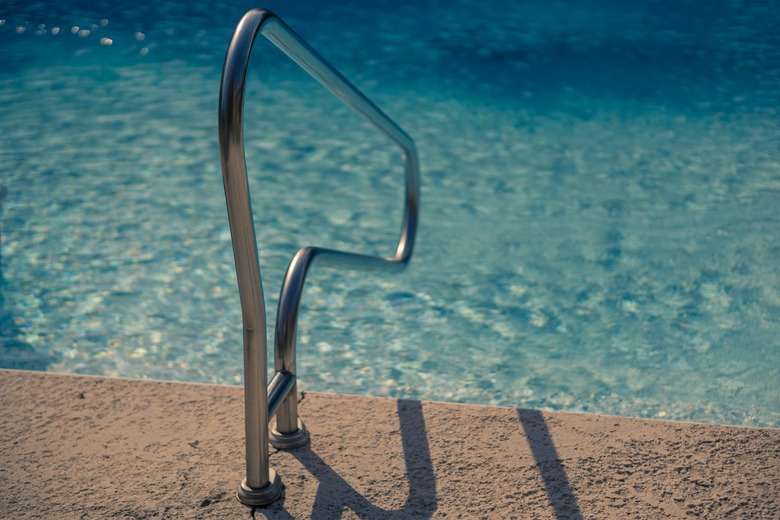Why Did The Water Turn Yellow In My Pool When I Added A Chlorine Tablet?
In its elemental state, chlorine is highly reactive, extremely poisonous and has a yellowish color. Don't worry, though–the yellow color you see in pool water when you throw in a chlorine tablet isn't caused by elemental chlorine. In pool water, chlorine ions immediately mix with water molecules to form colorless hypochlorous acid. If you see a yellow color in the water, it's usually caused by minerals–primarily iron. Iron is a common contaminant in wells and municipal water systems, and while it may be troublesome, it isn't a health hazard.
Ferrous and Ferric Iron
Ferrous and Ferric Iron
Well water and water from municipal systems often contains a high concentration of iron. As long as the iron is in the ferrous state, however, it's completely dissolved, and the water may be crystal clear — as long as it is free of other contaminants. However, in the presence of an oxidizing agent, such as chlorine tablets, ferrous iron loses an electron and becomes ferric, making it insoluble. Ferric iron is essentially rust, and the yellow color you see around a chlorine tablet is due to the presence of microscopic rust particles suspended in the water.
The ferric state is more stable, so ferric iron won't revert to the ferrous state. This means that the rust particles produced by the chlorine tablet are there to stay. The yellow color will probably disappear, though, as the rust dissipates in the pool water.
Is Iron Safe?
Is Iron Safe?
Many people who get their drinking water from a well regularly ingest large amounts of iron every day without suffering ill effects. To suffer a lethal dose, the average person would have to ingest about 4 grams at one time. Add to this the fact that the human body can't process iron from drinking water in the first place, and it's clear that iron in the water doesn't pose a health threat, as a World Health Organization report concluded.
The main problem with iron is that it stains things. If you allow the concentration of ferric iron in your pool to get unusually high, it will turn the lining, the bottom and everything else that is permanently submerged a rusty brown color. Think of the unsightly brown stains on the inside of an old basement toilet bowl, and you get the idea.
Do I Need to Do Anything?
Do I Need to Do Anything?
Pool water that contains iron also contains other minerals, including manganese, copper, aluminum and calcium in the form of calcium carbonate, which is responsible for the white scale that can clog up pool equipment. If you notice yellow coloration in the water, it's a good time to test the mineral content. If the total dissolved solids exceed 5,000 parts per million, it's time to act.
One solution is to add a sequestering agent, which ties up minerals in solution and prevents them from precipitating out and causing stains and scale. A more complete strategy, especially if the water is discolored, is to shock the pool, and then add a flocculant. Next, vacuum out the sediment that falls to the bottom. In some cases, you may have to drain some of the water and replace it to reduce the mineral content.
Final Steps to Take
Final Steps to Take
After the chlorine tablet dissolves, the water should turn clear again as the iron dissipates. If this doesn't happen, the iron concentration may be unusually high, especially if the yellow coloration has a brownish tinge. After flocking the pool to remove the precipitated iron, you may want to devise a better filtration system for the water you use the fill the pool. Water softeners designed to remove calcium from the water also remove iron and other minerals, and hooking one up to the pool supply–or to the entire house–is relatively easy and inexpensive.
Possible Algae Growth: It's important to remember that the yellow coloration may be the early sign of an algae growth. You should suspect this and take appropriate action if more than one of the following conditions apply:
- The yellow color doesn't go away.
- You see algae spots on the sides of the pool, the stairs or the bottom.
- The water tests low for minerals.
- The chlorine concentration was well below 1 ppm before you added the tablet.
- The weather has been hot and sunny.
